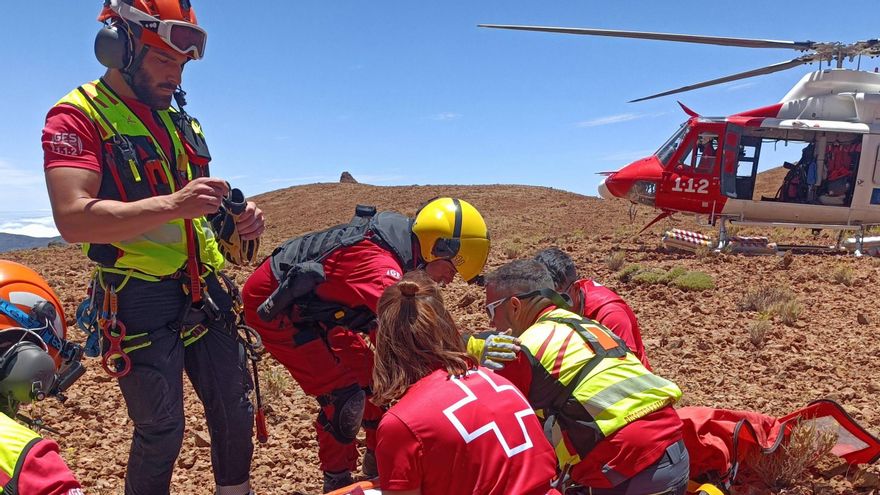
The National Park of Teide, due to its high altitude, hosts several of the most challenging trails in Spain. Lack of physical preparation, overconfidence, and deviating from the route are some of the triggers that lead to emergency personnel constantly acting in the area. Specifically, at least three incidents have been recorded in the vicinity in the last week, two rescues and a fire alert. The accidents involving distressed hikers, all non-resident tourists, took place on the same day and along the same route: the one that ascends and descends from the crater.
Monday was marked by a rescue. A 43-year-old woman suffered a fall that prevented her from continuing the hike while on the Mountain Blanca to Altavista trail. The Coordinating Centre for Emergencies and Security (CECOES) 1-1-2 of the Government of the Canary Islands activated the necessary emergency resources. Members of the Immediate Emergency Response Team (ERIE) of the Spanish Red Cross, deployed by the Consortium of Firefighters of Tenerife, reached the affected individual and provided initial assistance until the GES helicopter proceeded with the evacuation.
Monday night was also eventful. The Fire Departments of La Orotava, La Laguna, and Santa Cruz were called out during the night to rescue two hikers. One of them sustained an ankle injury that prevented further walking. José Carlos Herrero, mountain guide and national parks expert, emphasises that embarking on a trail in the National Park of Teide requires excellent physical condition, as most trails are at over 2,000 meters in altitude, some even reaching 3,715 meters. Being a high mountain area where weather conditions can change significantly, he points out that “being well-equipped is crucial.” The night temperature differs greatly from that of the day, and not having the right gear is one of the reasons why a fee is charged for rescue services such as helicopter evacuations.
[–>
Herrero reveals that the recent rescues have taken place on trail number 7, which goes from Mountain Blanca to Pico Teide. “It is a very demanding route, requiring excellent physical condition, proper equipment, and much more. Planning the activity is paramount, not just in terms of gear; other aspects like weather forecast and sunset time need to be checked.”
José María Pérez, mountain guide and sports technician, highlights that the issue lies in many using the night to access the Peak without the necessary permits. At night, there are no guards, so many people ascend to watch the sunrise without any control and lacking appropriate clothing. “That’s the main risk, many people are unaware that it is high mountain terrain. Furthermore, the crater’s capacity is usually exceeded because those without permits still walk up.”
Mountain guide José Carlos Herrero explains that there are two reasons why one should not stray from the trails: “Firstly, to avoid personal risks because a trail is the safest route, and secondly, also importantly, it is the path on which we will cause the least impact on the environment.” Many rescues occur because people venture off the marked zone, get disoriented, and have accidents.
He warns that “Environmental Education is vital to raise awareness about the fragility of a unique territory.” While not in favour of charging for rescues, as he prefers education for prevention, he acknowledges that a special area like the National Park requires more surveillance and penalties.
[–>
The streak of bad luck started on Sunday afternoon when a fire alert broke out near the road frequented by many vehicles. The firefighting teams managed to extinguish the fire in 45 minutes, after it had spread about 300 meters, affecting broom plants and weeds. Herrero asserts that 99% of the blazes near the road are caused by cigarette butts thrown from cars.
















